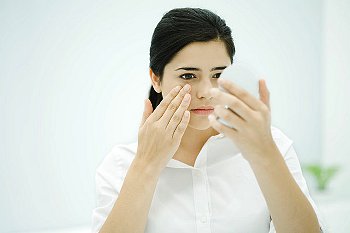
Many people new to contact lenses, and even some experienced wearers, have practical questions about contacts.
In order to help ensure crisp, clear vision, better eye health and maximum lens wearing comfort, there are a few things to consider for successful lens wear and care.
Like us on Facebook!
1. Before You Touch Your Lenses
Always wash your hands before you put your lenses in or take them out. Don’t lather up with oily or heavily scented soaps. Lenses can cling to wet hands, so dry your hands well with a lint-free towel. If you want to use a moisturizer, wait until after you’ve put in your lenses. The residue from lotions can stick to them.
2. How Long Can I Wear My Lenses?
Replace your lenses as often as the doctor suggests, even if you don’t wear them every day. For instance, if you have the disposable kind that are good for one wearing, throw them out after you’ve worn them once, even if they still feel fresh. When you wear lenses for more days than you should, or when you sleep in lenses that aren’t made for overnight wear, you raise your risk of eye infections.
3. Water and Lenses Don’t Mix
If you’re out of contact lens solution, you might be tempted to rinse your lenses with tap water. Don’t do it! Water sometimes has microbes that can cause serious eye infections. Don’t even wear contacts in the shower. And never put your lenses into your mouth or use saliva to wet them.
4. Contact Lenses and Sports
You can wear your lenses for most sports and activities. They rarely move or fall out. Plus, they don’t fog up like glasses, and they give you better peripheral vision. If you swim, though, make sure you wear watertight goggles. You can get an eye infection from water, and your lenses can be hard to take out if they get wet. Use saline or re-wetting drops to loosen them, and then clean and disinfect them afterward.
5. When Your Lenses Hurt
A lens might feel uncomfortable if there’s something on or under it, or if it’s inside out. Take the lens out and rinse it with re-wetting drops or a non-peroxide solution to remove the dirt or dust. Look at it from the side. If there are marks on the edge and you can read them, the lens is OK. If the shape is a “U,” then it’s fine. If it’s a “V” with the top edges flared out, turn it around, rinse, and place it back in your eye. If that’s not better, see your eye doctor.
6. Allergy Sufferers
If you suffer from allergies, wearing contacts can make your symptoms worse since allergens like pollen and dander can stick to the lenses. Wear glasses if your symptoms are really bad, and if you can’t part from your contacts (I don’t blame you), be sure to clean them thoroughly or replace disposable lenses more often.
7. Computer Strain And Dry Eyes
Keep eye drops in your purse or desk at all times, especially if you work at a computer. Not only are dry lenses uncomfortable and difficult to see out of, but they could potentially scratch your eye. Use those drops as often as you need. If you have watery or itchy eyes caused by allergies, look for drops containing antihistamines.
